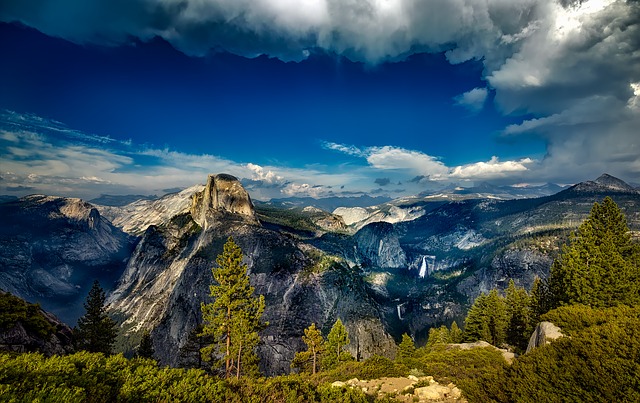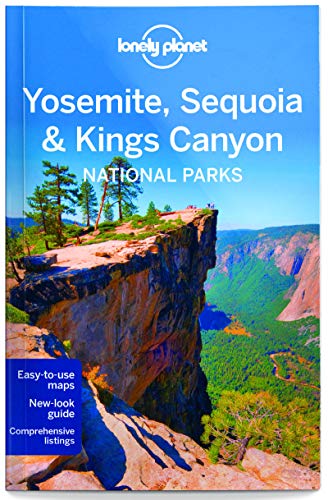Yosemite National Park is home to some of the most iconic hikes in the world, and Half Dome is the crown jewel of them all. Rising over 8,800 feet above sea level, Half Dome's distinctive shape dominates the landscape. It normally takes between 10-14 hours to complete this round-trip trek.
This challenging but rewarding trek offers stunning panoramic views of Yosemite Valley and beyond.
My guide will provide you with everything you need to know before beginning your journey to the magnificent Half Dome.
Half Dome Yosemite Hike Overview
The Half Dome is famous for its iconic granite rock formation and 14-mile journey into the wilderness of Yosemite. Yosemite National Park is found in the Sierra Nevada Mountains in California. Read this article for more hikes in California.
There are many beautiful mountains in America but the Half Dome is famous worldwide as a World Heritage Site and for its dramatic geologic formations. Within these granite rocks and cliffs, numerous waterfalls flow year-round and massive ancient sequoia trees shield the valleys.
The most common way to begin your adventure to the Half Dome is via the Mist Trail. There are other alternative ascent trail options, such as Glacier Point or via Tenaya Lake. The Mist Trail is 14.2 miles round trip, making this route the shortest and most scenic. Most hikers take 10-14 hours to complete this. The best time to visit the Half Dome is anytime from late May to October.
The Half Dome is a 14-mile round trip hike with an elevation gain of 4,800ft. This is one of the longest and steepest day hikes in Yosemite. In 1865, it was reported to be inaccessible.
Those who are experienced climbers will take on the challenge of climbing on the Northwest face of the Half Dome, making this a U.S. first Grade VI climb. We've included this trail on our list of the most dangerous hikes in the world.
Hiking to the Half Dome via the Mist Trail is a less daunting option but still requires you to be physically fit and have previous hiking experience. There is a mountaineering component at the end with cables leading you to the top of Half Dome.
Yosemite Half Dome Hike Route
Your journey will begin near the Happy Isles Bridge that crosses the Merced River. Due to the Half Dome’s famous reputation, the trails can get crowded.
To prevent this, the park has required everyone to obtain a permit. Half Dome hike permit allows you to access the cable route that gets you to the top of the Half Dome. You must apply for this permit in advance. They are awarded on a lottery basis beginning in March. You can apply for the permit online or by phone and it costs $10.
On the Mist Trail, you will climb hundreds of steps right beside Vernal Falls. It is crucial you take caution in this area, as the steps will be wet and slippery. Once you reach the top, you will hike beside Nevada Falls. Once you’ve surpassed the falls, there will be a decent length of flat ground through Little Yosemite Valley. After hiking through more forest-area, you will reach the sub dome.
This is what will lead you to the cables. The sub dome steps are at 8,000 ft. The cables are up from late May to early October. One thing to note is that the cable section is not for those who are afraid of heights. You are completely exposed and walking up vertically. Once you have reached the top of the cables, you are faced with spectacular views of the iconic vistas of Yosemite.
Half Dome Quick Facts
- Elevation: 6,100 feet (1,860 meters)
- Difficulty: Strenuous (requires physical fitness, especially on the cable route; it's the most difficult in Yosemite
- Granite dome located in the eastern park of Yosemite Valley
- The Half Dome Cable Route hike is 8.2 mi (13 km) and goes up to 4,800 ft (1,460 m)
- Length: around 14 miles (23 km)
- Very popular and gets busy in summer
- Permit is required (preferably for weekdays, as it's less crowded)
- Quickest route: Via the Mist Trail
Permits For The Half Dome Hike
Anyone who hikes the Half Dome must obtain a Wilderness Permit beforehand. These are awarded by lottery at the beginning of the month of March.
It is $10 a person and you are able to apply via online on the National Recreation Reservation Service or by phone at 877-444-6777.
You must apply for the permit at least two days ahead of your intended hiking day.
To increase your chances of obtaining a permit, apply for less popular days such as Sunday’s-Thursday’s in September and October.
Difficulty Of The Half Dome Trail
The Half Dome is one of the most difficult day hikes at Yosemite. It is strenuous and will require physical fitness and mountaineering skills on the cable route.
If you are not comfortable with heights, you may want to avoid the cable route.
Hikers report this being the most difficult section of the hike.
Half Dome Hike Map
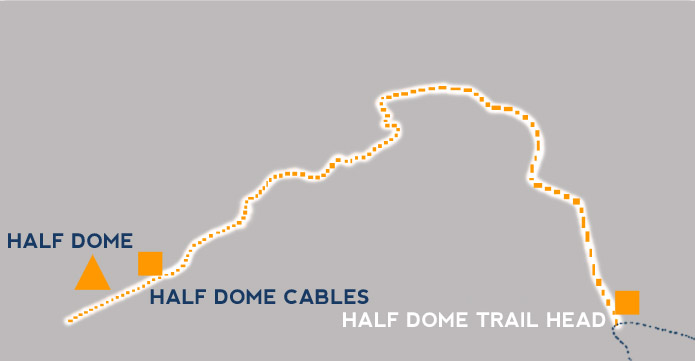
The Half Dome is found east of Yosemite Valley. If you are using the Mist Trail, your journey will begin near Curry Village.
This 14-mile day hike begins on the Mist Trail, to the top of Vernal and Nevada Falls, through Little Yosemite Valley, up to the Sub Dome, and to the cable route where you will reach the top of the Half Dome.
Yosemite Half Dome Guidebook
One Best Hike: Yosemite’s Half Dome by Rick Deutsch is a wonderful guide to prepare you for the Half Dome. It shares what to bring, a detailed trail description with altitudes, and other sights you should stop and see along the way.
For an overview of Yosemite National Park, Lonely Planet Yosemite, Sequoia & Kings Canyon National Parks by The Lonely planet is an excellent read. It features maps, itineraries, insider tips, and reviews for what to eat and where to sleep within Yosemite.
Please Note
This is a strenuous hike that requires proper physical fitness and preparation. There are risks of twisting and spraining ankles near the falls due to the slippery conditions. There is some mountaineering skill required with the cables towards the top of the Half Dome.
You will be climbing vertically and you will be completely exposed. Other risks that have occurred on this hike are heat exhaustion, dehydration, and hyponatremia (low electrolyte levels). To avoid this, drink plenty of water, eat along the way, and take frequent breaks in the shade.
Half Dome Trek Itinerary
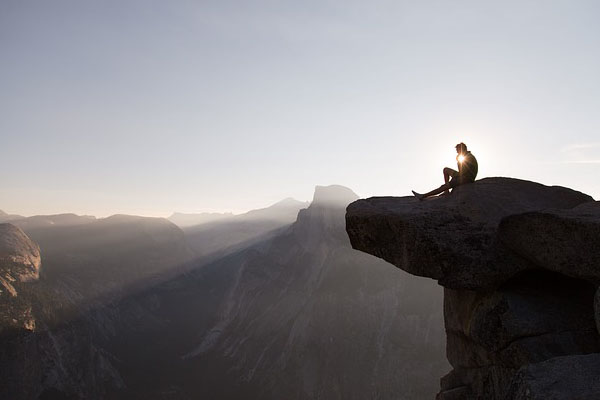
It is crucial to begin this hike at dawn. It will take you approximately 12 hours and you will want daylight left on your descend. There are other trails to get to the Half Dome but the Mist Trail remains the most popular and scenic route.
- To the top of Vernal Falls: Begin your hike on the Mist Trail to the top of Vernal Falls (1.5 miles)
- Vernal Falls to Nevada Falls: Begin your hike on the Mist Trail to the top of Vernal Falls (1.5 miles)
- From Nevada Falls to Sub Dome: Continue through Yosemite Valley until you reach the Sub Dome (approx. 3 miles)
- From Sub Dome to Cable Route: Climb up the Sub Dome until you reach the cable route
- The Cable Route: Go up the cable route (400ft)
Return on the same itinerary to descend
Half Dome Hike FAQ
How long is Half Dome hike?
The distance of the Half Dome hike varies depending on the route taken, but typically covers a round-trip distance of approximately 16 miles and takes 10-14 hours to complete.
The length of the hike can be deceiving, as it's not just the distance that makes it challenging, but also the steep elevation gain and the final ascent up the cables to the summit.
And don't be fooled by the name, because you're going to want the whole dome by the end of it. The hike is so tough, that it might have you questioning every life decision you've ever made!
Should I worry about Half Dome hike deaths? How many are there?
The US National Park Service reports that an average of one or two deaths occur on the Half Dome hike each year. So the Half Dome hike is not exactly a walk in the park - unless your idea of a park involves scaling steep granite cliffs and clinging to cables for dear life.
It's difficult to determine the exact percentage of all hikers who die on the Half Dome hike each year without knowing the exact number of hikers who attempt the hike annually. However, based on the information available, a percentage of estimated Half Dome hike deaths is likely less than 0.001%.
Now, let me put this number into perspective. Every year, hundreds of thousands of people hike Half Dome, and the overwhelming majority of them make it back down safely. So, while it's important to take precautions and be aware of the risks, there's no need to let fear stop you from attempting the hike.
It's crucial to take the necessary precautions to minimise the risks. This includes things like wearing appropriate footwear, bringing plenty of water and food, and knowing your limits.
What is half dome hike elevation gain?
With 4,800 feet elevation gain, the Half Dome hike is no joke. In total, the elevation gain on the Half Dome hike is roughly the height of two and a half Empire State Buildings stacked on top of each other. But, who's counting? All you need to know is that you're gonna be climbing like a champ, and the view from the top is worth every step.
When is the best time to hike Half Dome?
You cannot climb Yosemite without the cables. These were installed in 1919 to help hikers reach the summit. But they aren't there all year round. The climbing cables are in place from late May to October. If you’d like to see the waterfalls at their fullest, the best time to hike Half Dome trail is in spring in May or June.
It’s extremely important to avoid the Half Dome in bad weather, especially if rain or thunder is in the forecast. The trail can become very dangerous.
What gear do I need for the Half Dome Hike?
Hiking the Half Dome requires a few pieces of essential gear. The Mist Trail near the waterfalls is slippery. This calls for hiking boots with excellent traction. Trekking poles are also a great idea. In case your journey back goes past dusk, a headlamp is a must.
When hiking in hot temperatures, you must wear sunscreen and a hat. When going up the cable route, gloves are helpful. You will want to drink 1 gallon of water if you are hiking to the top of the dome and back. Bring plenty of food and snacks as well.
What weather should I avoid when hiking the Half Dome?
The Half Dome can become very dangerous especially during a lightning storm. You must check the weather beforehand and begin your hike early, as most thunderstorms tend to occur in the afternoons. Keep in mind that the weather can change at different altitudes, so keep an eye out for storm clouds and signs of bad weather.
Can I camp on my journey to the Half Dome?
Yes. If you are looking to lengthen your hiking journey, spend the night at Little Yosemite Campground, a mile away from the top of Nevada Fall. This means you will need to pack and carry all your own gear (sleeping bags, food, cooking gear, etc). As long as you have your Wilderness Permit to hike Half Dome, you are all set to camp in Little Yosemite Valley.
What wildlife could I potentially come across on the Half Dome Hike?
Black bears are known to roam around Yosemite both day and night. Always keep food secured and put away. If you do see a bear, make sure to make as much noise as possible to scare it away. Other small critters include squirrels, chipmunks, and stellar jays. It is important to never feed wild animals.
Where can I get water on Half Dome cables hike?
There are three locations to fill up on water, which is crucial for this hike. There is a refreshment stand at Happy Isles near the trailhead of where you begin your hike. There is a small drinking fountain at the Vernal Fall footbridge. Lastly, if you have a filtration system on hand, stop at the Merced River in Little Yosemite Valley. This is the last place for water until you return back down.
Is altitude sickness a risk?
Yes. The Half Dome is at 8,839ft and this hike does require you to gain 5,000ft in elevation. There are very steep sections of the hike, especially when you reach the Sub Dome onwards to the cable route.
It is important to have a solid understanding of the risks associated with high altitude hiking and how the body acclimatizes to high altitude. We recommend you read our detail article on Altitude Sickness and Acclimatization.
Other hikers have also experienced heat exhaustion, dehydration, and hyponatremia (low electrolyte levels). It is crucial to drink plenty of water, eat along the way, and take frequent breaks in the shade.
What travel insurance do I need?
Hiking insurance is crucial for the Half Dome. If an accident or incident should occur that requires immediate medical assistance and evacuation you will most definitely want adequate hiking insurance that can cover the costs of air ambulance and treatment.
The nearest location for help is the Little Yosemite Valley Ranger Station. It is staffed during the summer and located on the North side of the valley.
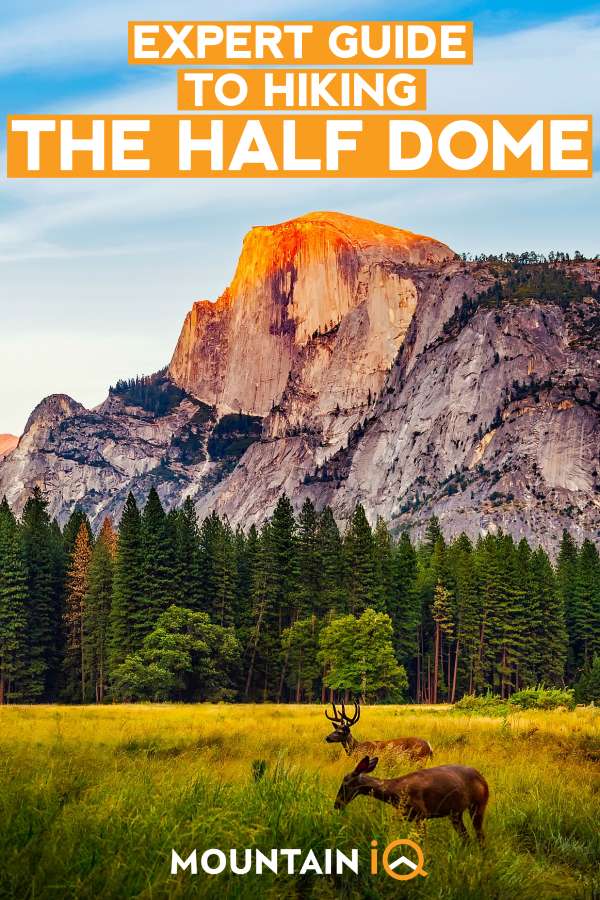
Browse more US National Park hikes
See our picks for the Best Hikes in America, or check out these popular hikes.

